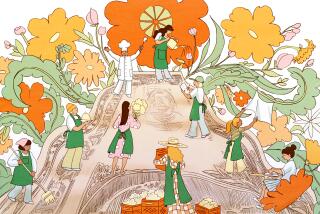Hungry for a supermarket
I DON’T like supermarkets. I’m not a cook. I hate the relentless fluorescence, the insipid music. For years, I eschewed grocery shopping altogether and ordered meals to go from various places along the Hollywood/Wilshire corridor that I traveled on my way home from work -- Thai, Indian, health-conscious California.
My disdain of supermarkets, I realize, is a luxury. I now live far south of the Hollywood/Wilshire corridor, in Inglewood, where lots of folks don’t have that luxury. And the resulting lack of access to healthy food is seriously affecting community health. The situation has reached a crisis point in the last several years as the gap between African Americans’ health and that of the rest of the nation deepens and the consolidation of supermarkets reduces choice for everybody.
The choice has been reduced most sharply and swiftly in South L.A. Ralphs has closed four stores there in the last 18 months, part of a plan that closed 15 locations in Southern California after the devastating four-month supermarket strike and lockout in early 2004. (Many of us who honored the picket line, only to see the union lose, are still ambivalent about returning to Ralphs to shop -- and we’re also ambivalent about grocery chains using the strike as an excuse to leave areas that were underserved to begin with.)
Besides heaving yet another sigh about yet another loss for South L.A., what to do? The first thing is to define the issue. This is not simply another inner-city retail problem. It is a public health problem. (And if one aspect of the problem is too few supermarkets, another is too much fast food; in many middling-to-poor neighborhoods, it’s hard to walk a block along a main drag without passing a KFC or a Taco Bell. But that’s another column.)
Community Health Councils, a nonprofit organization that has researched the correlation between a community’s health and its supermarkets and restaurants, discovered that the Ralphs closures leave 14 full-service supermarkets in 20 ZIP Codes from Ladera Heights to Watts, many of them clustered to the west.
There are also some self-serve grocery warehouses, such as Food 4 Less, in these areas. But such warehouses tend to stock just the basics. They don’t often sell whole grains, organic food or other products available in grocery stores in places outside those 20 ZIP Codes. Community Health Councils is trying to remedy the problem through public policy (advocating legislation for tax breaks for chains that locate in South L.A.) and moral suasion (appealing to companies to open stores there or upgrade existing ones because it’s the right thing to do).
I don’t have much faith in the latter approach. Gwendolyn Flynn, project manager for the organization’s “Reach 2010” campaign, a federally sponsored program to promote better health, admits that Ralphs is not the only chain reluctant to set up shop in the ‘hood. Trader Joe’s has zero presence in South L.A. but has a large black clientele. Clearly Trader Joe’s sees nothing wrong with the current arrangement: A certain demographic of its customers comes to its stores already, so why should it go to them? The latest rumor, however, has it that T.J.’s may finally be coming to Century Boulevard in Inglewood, where distinctly yuppie emporiums such as Bed, Bath & Beyond, Jamba Juice and Coffee Bean & Tea Leaf have opened in the last couple of years.
This goes a ways toward bolstering a stubborn belief I have that I’m sure every Angeleno shares: My neighborhood is moving on up. We believe this in spite of the fact that the middle class is disappearing in urban areas across the country -- and disappearing fastest in New York and L.A., where the divide between rich and poor is the most dramatic. The supermarket crisis is simply more confirmation of what we’ve all known (and what some of us have been experiencing) for a while. Yet I refuse to accept that we can’t know, and experience, something different.
A recent article in the Atlantic Monthly, summarizing a Brookings Institution report on the decline of the urban middle class, says that middle-class urbanites now tend to live in increasingly stratified neighborhoods -- “quasi-ghettoes or gold coasts.”
I know I don’t live in the former, but I don’t quite accept being in the latter either. What I do know is that the day I can buy healthy food in my neighborhood as easily as I can buy it on the way there is the day I will have truly arrived.
More to Read
Eat your way across L.A.
Get our weekly Tasting Notes newsletter for reviews, news and more.
You may occasionally receive promotional content from the Los Angeles Times.








